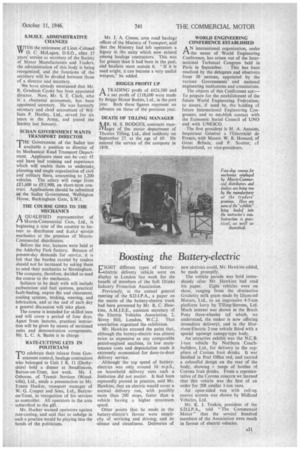Boosting the
Page 23

If you've noticed an error in this article please click here to report it so we can fix it.
Battery-electric
EIGHT different types of batteryelectric delivery vehicle were on display in London last week for the benefit of members of the Soft Drinks Industry Protection Association.
Previously, at the annual general meeting of the S.D.I.P.A., a paper on the merits of the battery-electric truck had been presented by Mr. R. C. Hawkins, A.M.I.E.E., assistant secretary of the Electric Vehicles Association, 2, Savoy Hill, London, W.C.2. That association organized the exhibition.
Mr. Hawkins stressed the point that, although the battery-electric was almost twice as expensive as any comparable petrol-engined machine, its low maintenance costs and depreciation made it extremely economical for door-to-door delivery service.
Although the top speed of batteryelectrics was only around 16 m.p.h., on household delivery runs such a limitation did not matter. It had been repeatedly proved in practice, said Mr. Hawkins, that an electric would cover a normal delivery run, with possibly more than 200 stops, faster than a vehicle having a higher maximum speed.
Other points that he made in the battery-electric's favour were simplicity of servicing and driving, and its silence and cleanliness. Deliveries of new elcctrics could, Mr. Hawkins added, be made promptly.
The vehicle parade was held imtnediately after Mr. Hawkins had read his paper. Eight vehicles were on show, ranging from the diminutive Graiseley milk pram made by Diamond Motors, Ltd., to an impressive 4-5-ton platform lorry by Tilling-Stevens, Ltd. Much interest was shown in the Brush Pony three-wheeler (of which, we understand, the maker is now offering immediate delivery), and in the Morrison-Electric 2-ton vehicle fitted with a special upswept canopy-type body.
An attractive exhibit was the N.C.B. 1-ton vehicle by Northern Coachbuilders, Ltd., for delivery to the suppliers of Corona fruit drinks. It was finished in Post Office red, and carried a colourful design on the rear of the body, showing a range of bottles of Corona fruit drinks. From a representative of the Corona concern we learned that this vehicle was the first of an order for 208 similar 1-ton vans.
An open-sided van with roll-up canvas screens was shown by Midland Vehicles, Ltd.
Mr. K. J. Tonkin, president of the S.D.I.P.A„ told "The Commercial Motor" that the several hundred members of the Association were much in favour of electric vehicles.




































































